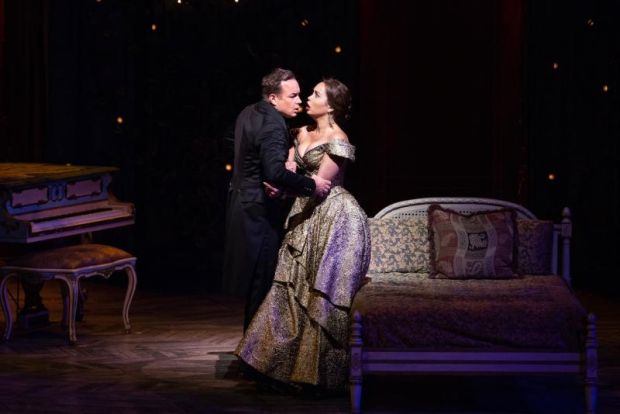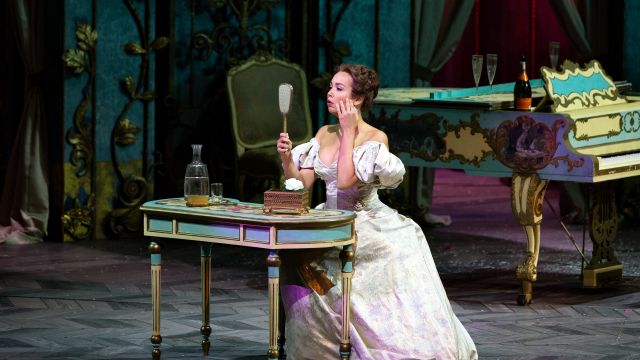La Traviata
Following on their success with Medea, the Metropolitan present one the world’s most cherished operas, La Traviata, in a fresh production for the cinema that sparkles and glitters while still giving us the drama we expect.
La Traviata is based on a real person, Marie Duplessis, the most fashionable 19th century courtesan in Paris and the uncontested queen of the horizontales who serviced the city's rich bourgeoisie, upper classes, artists, writers and musicians. As well as being the inspiration for La Dame Aux Camelias, her life and death would inspire one of Verdi's most famous operas, composed in 1853.

La Traviata tells the story of the tragic love between the courtesan Violetta and the romantic Alfredo Germont. Played out against the hypocrisy of upper-class fashionable society, Alfredo and Violetta's love threatens to shame his family.
This new staging by Michael Mayer has a far more opulent and realistic tone than the stark, high concept vision presented previously by the Met. Christine Jones’ scenic design appears to be specifically customised for the Met with the gold textured proscenium arch of the house continued into a false proscenium frame. This gilded pattern continues over the whole set and is even picked up as a decorative element on the costumes.

Just as Bridgerton colourised the pastel colours of the Regency period to make them pop, this production pushes the palette, featuring bright blue walls adorned with extravagant metal filagree. Little changes take place on stage during the three acts of the opera, apart from the lighting and what is suspended from or depicted in the large hole at the top of the set. If the colour mood is blue, love is in the air and a bleak wintery early morning sky sets the mood for Violetta’s demise.
Italian maestro Daniele Callegari leads the Metropolitan Opera Orchestra in a sensitive performance which supports the lead singers in their moments of individual interpretation.

The opera opens spectacularly, with the ensemble members looking impeccably glamorous in vivid spring-toned, gold-trimmed costumes by Susan Hilferty (of Wicked fame). In fact, the Met chorus play a spirited part in their two-party scenes and making the most of even the smallest roles; notably Siphokazi Molteno’s Flora, Brian Major’s Baron, and Eve Gigliotti’s Annina.
However, a good La Traviata is rightfully judged by the singer playing Violetta, and the Met are fortunate to have the services of Nadine Sierra who has established a reputation as one of today’s finest young artists, in demand at the world’s most prestigious opera houses.

Sierra gives Violetta vulnerability but with more than a touch of headstrong abandon which comes through with sterling clarity in her performance, both singing and acting. She sings an individualised coloratura at the end of “Ah, fors’è lui” that, even though this is a recording, it is no exaggeration to say that you could have hear a pin drop at the Met, as the full house hold their breath.
Whether in the breathless, fast-paced “Sempre libre,” or spinning out seamless legato lines in Violetta’s farewell to life, “Addio, del passato,” Sierra combines beauty of tone with emotion to create a riveting a very much real-life Violetta.

As Giorgio, Italian baritone Luca Salsi gives us vocal power that seems effortless, allowing him to present a very naturalistic acting performance. Salsi’s velvety voice blends beautifully with Sierra’s; the finely calibrated sequence of sequences in their extended act two duet is a true pleasure to hear!
As Alfredo, Stephen Costello is equal parts fervent, impulsive and idealistic. Costello, like Sierra, is the physical embodiment of his role. His voice is sure and true, whether leading the rousing Act I Brindisi or hurling out insults. It’s as a lover, however, that Costello is at his best, especially in “De’ miei bollenti spiriti … Il giovanile ardore” in the second act in which he gives voice to the full expression of Alfredo’s love for Violetta.
The third act features an elaborate ballet in which guests dressed as Spanish gypsies perform a dance combining the themes of passion, money, and death which run through Traviata. In this production Mayer has interpreted this as Violetta reliving her past life in spirit – as the representation of the Latin American Dia de los Muertos (Day of the Dead).
La Traviata is a glowing gem in the crown of the Met’s Live and HD Series and a wonderful way to spend 3 hours savouring some of the best opera in the world!
Barry Hill
Subscribe to our E-Newsletter, buy our latest print edition or find a Performing Arts book at Book Nook.

